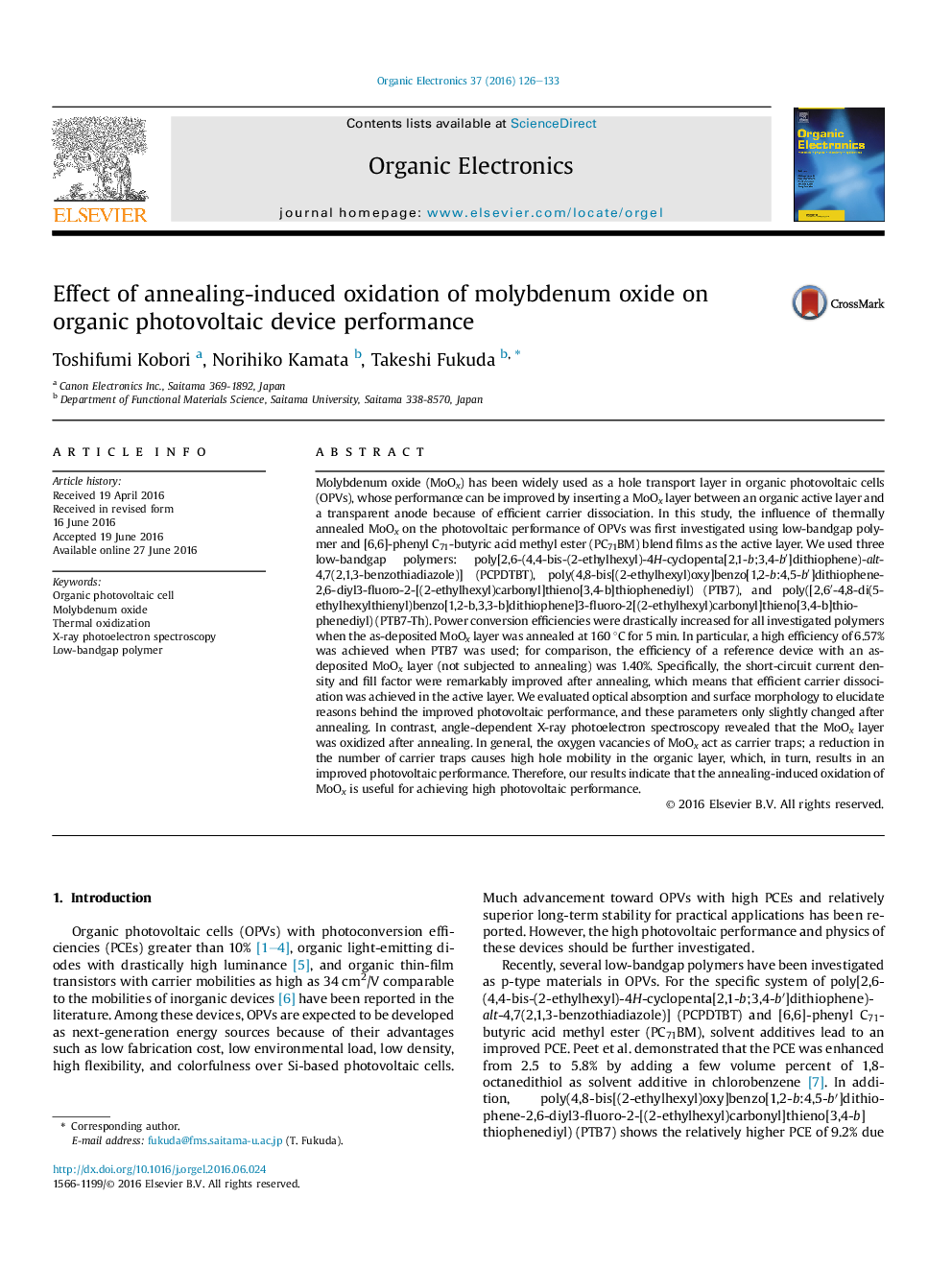| کد مقاله | کد نشریه | سال انتشار | مقاله انگلیسی | نسخه تمام متن |
|---|---|---|---|---|
| 1264665 | 1496820 | 2016 | 8 صفحه PDF | دانلود رایگان |
• The thermal annealing induced the oxidation of the MoOx thin film.
• The oxidized MoOx leads the improved photoconversion efficiency of organic photovoltaic cell.
• The oxidation of MoOx is estimated from the angle-dependent XPS spectrum.
• The oxygen vacancy of MoOx act as the carrier trap, which causes the low carrier mobility.
Molybdenum oxide (MoOx) has been widely used as a hole transport layer in organic photovoltaic cells (OPVs), whose performance can be improved by inserting a MoOx layer between an organic active layer and a transparent anode because of efficient carrier dissociation. In this study, the influence of thermally annealed MoOx on the photovoltaic performance of OPVs was first investigated using low-bandgap polymer and [6,6]-phenyl C71-butyric acid methyl ester (PC71BM) blend films as the active layer. We used three low-bandgap polymers: poly[2,6-(4,4-bis-(2-ethylhexyl)-4H-cyclopenta[2,1-b;3,4-b′]dithiophene)-alt-4,7(2,1,3-benzothiadiazole)] (PCPDTBT), poly(4,8-bis[(2-ethylhexyl)oxy]benzo[1,2-b:4,5-b′]dithiophene-2,6-diyl3-fluoro-2-[(2-ethylhexyl)carbonyl]thieno[3,4-b]thiophenediyl) (PTB7), and poly([2,6′-4,8-di(5-ethylhexylthienyl)benzo[1,2-b,3,3-b]dithiophene]3-fluoro-2[(2-ethylhexyl)carbonyl]thieno[3,4-b]thiophenediyl) (PTB7-Th). Power conversion efficiencies were drastically increased for all investigated polymers when the as-deposited MoOx layer was annealed at 160 °C for 5 min. In particular, a high efficiency of 6.57% was achieved when PTB7 was used; for comparison, the efficiency of a reference device with an as-deposited MoOx layer (not subjected to annealing) was 1.40%. Specifically, the short-circuit current density and fill factor were remarkably improved after annealing, which means that efficient carrier dissociation was achieved in the active layer. We evaluated optical absorption and surface morphology to elucidate reasons behind the improved photovoltaic performance, and these parameters only slightly changed after annealing. In contrast, angle-dependent X-ray photoelectron spectroscopy revealed that the MoOx layer was oxidized after annealing. In general, the oxygen vacancies of MoOx act as carrier traps; a reduction in the number of carrier traps causes high hole mobility in the organic layer, which, in turn, results in an improved photovoltaic performance. Therefore, our results indicate that the annealing-induced oxidation of MoOx is useful for achieving high photovoltaic performance.
Figure optionsDownload as PowerPoint slide
Journal: Organic Electronics - Volume 37, October 2016, Pages 126–133
